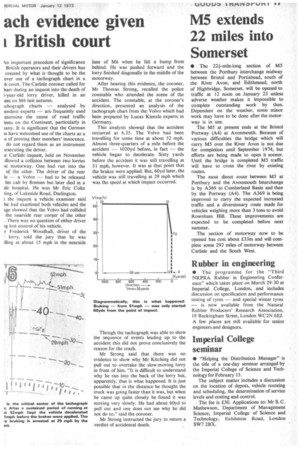ach evidence given British court
Page 19

If you've noticed an error in this article please click here to report it so we can fix it.
Ntn important precedent of significance British operators and their drivers has created by what is thought to be the ever use of a tachograph chart in a ,h court. The Carlisle coroner called for hart during an inquest into the death of -year-old lorry driver, killed in an lent on M6 last autumn.
Lchograph charts — analysed by lendent experts — are frequently used eterrnine the cause of road traffic lents on the Continent, particularly in iany. It is significant that the German is have welcomed use of the charts as a s of proving their members' innocence. do not regard them as an instrument rsecuting the driver.
Le Carlisle inquest, held on November )llowed a collision between two lorries le motorway. One had run into the of the other. The driver of the rear le — a Volvo — had to be released his cab by firemen but later died in a tie hospital. He was Mr Eric Colin ling, of Lakeside Road, Darlington.
t the inquest a vehicle examiner said he had exarriined both vehicles and the tge showed that the Volvo had collided the nearside rear coriler of the other . There was no question of either driver rg lost control of his vehicle.
r Frederick Woodhall, driver of the lorry, told the jury that he was ;Ring at about 15 mph in the nearside lane of M6 when he felt a bump from behind. He was pushed forward and the lorry finished diagonally in the middle of the motorway.
After hearing this evidence, the coroner, Mr Thomas Strong, recalled the police constable who attended the scene of the accident. The constable, at the coroner's direction, presented an analysis of the tachograph chart from the Volvo which had been prepared by Lucas Kienzle experts in Germany.
This analysis showeti that the accident occurred at 6.35. The Volvo had been travelling for some time at about 52 mph. Almost three-quarters of a mile before the accident — 1020yd before, in fact — the vehicle began to decelerate. Sixty yards before the accident it was still travelling at 51 mph, however. It was at that point that the brakes were applied. But, 60yd later, the vehicle was still travelling at 29 mph which was the speed at which impact occurred.
Though the tachograph was able to show the sequence of events leading up to the accident this did not prove conclusively the reason for the crash.
Mr Strong said that there was no evidence to show why Mr Kitching did not pull out to overtake the slow-moving lorry in front of him. 'It is difficult to understand why he ran into the back of the lorry but, apparently, that is what happened. It is just possible that in the distance he thought the truck was going faster than it was, but when he came up quite closely he found it was moving very slowly. He had about 60yd to pull out and one does not see why he did not do so," said the coroner.
Mr Strong instructed the jury to return a verdict of accidental death.








































































































